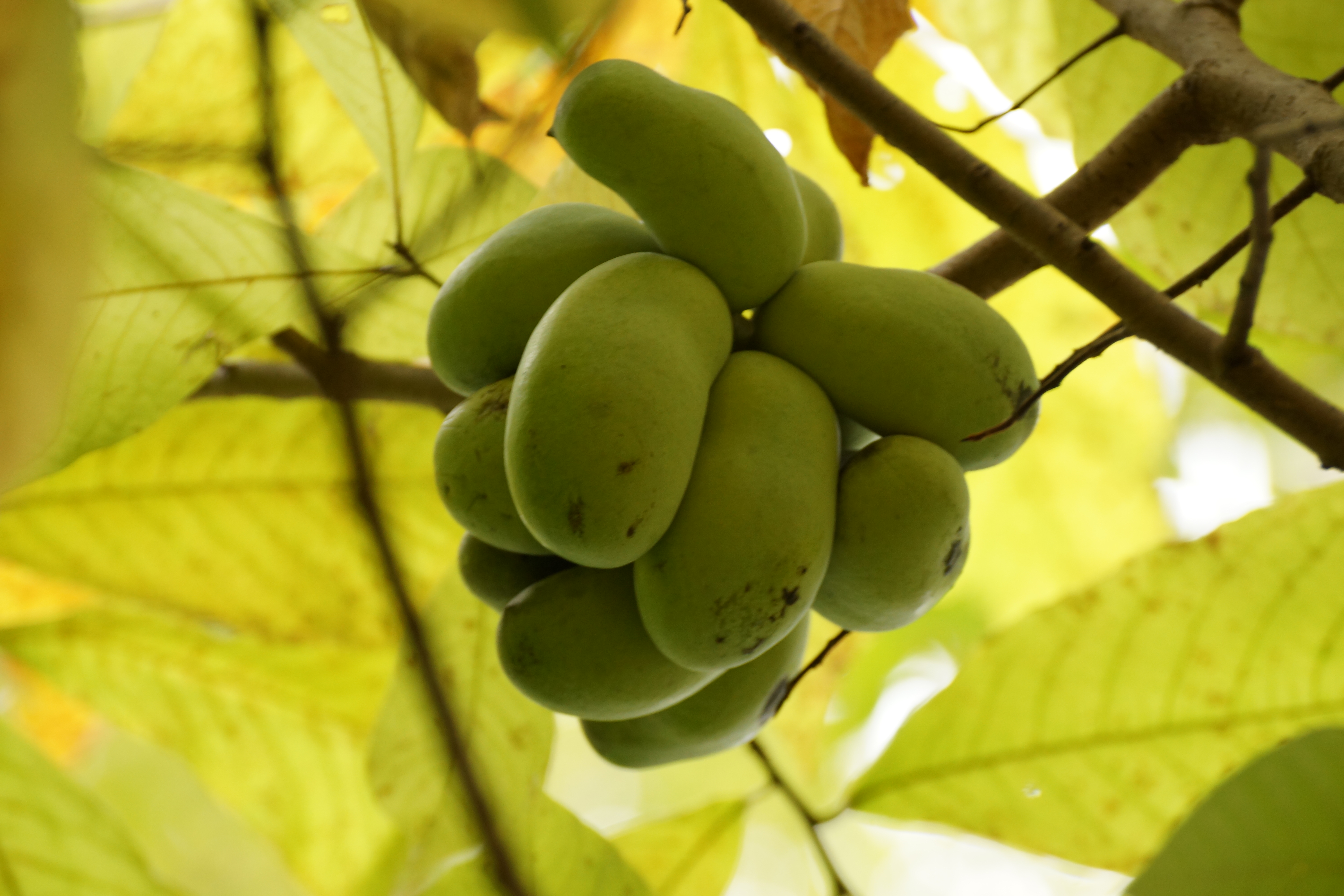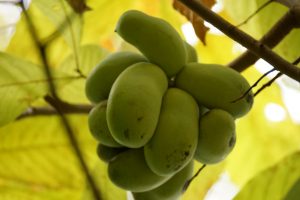Experience-Seeds-Knowledge-Plant Discoveries-Ecological Enrichment-Join Now Click Here!


Time to Prune: Stem Density and the Life of the Pawpaw Colony
Time to Prune: Stem Density and the Life of the Pawpaw Colony |

|
In 1988 I made a planting of pawpaw not really thinking of how it would be managed or how I would take care of it. As time passed on so did the growth of my colony swelling to 4 times its original size in just 30 years. Since I did not mow (I do not own a tractor), the hidden underground stolons have slowly sprouted into new trees in a forever expanding pawpaw universe. Now an under-story plant, pawpaw has become established in our nearby walnut, ash, pear and oak plantings. Pawpaw is showing this two-story agriculture as envisioned by J. Russel Smith in Tree Crops: A Permanent Agriculture works! But like all horticultural endeavors, there was a trade-off. The yields were low. The stem density was way too high with few lateral fruiting branches and small diameter sprouts. There was one area of the colony that was so dense, little if any fruit would form. You could barely walk through it. To increase the lateral branch size and stem diameter, I am removing a portion of the stems by pruning this winter. I am decreasing stem density. Next winter I will continue this project which will gradually increase yield without weakening the overall colony. Pruning pawpaw is easy. The wood is the hyperspace of loppers-light and easy to cut. I now am the proud owner of a lot of nice walking sticks too! We can also walk through there much easier without bumping shoulders with the pawpaw trees. The Long-Term Benefit of Seedlings: Not Grafted It takes about 20 to 30 years for the main trunk of a fully mature pawpaw tree to fail. This is when the trunk begins to crack, and the internal wood will turn black. Basically, the tree has done its job and is going into retirement. For a seedling pawpaw this means the roots will generate numerous tops all along the underground stolon which will go into an ever outwardly expanding root system. Now the roots are feeding a new top which is likely fruiting and is only a few feet away from the parent tree. The grafted tree doesn’t have that luxury. It is on top of a seedling tree. The grafted tree cannot sprout new roots, but the seedling under-stock might if you have not pruned or mowed them off. If you have a grafted tree, it is not bad but it has great limitations. You have a named variety selected for a specific characteristic that may not be evident in all pawpaw fruit. It may have less seeds or even be a larger fruit that tastes a certain way. But it cannot regenerate itself. For that you will need a new tree to replace it. It is the evolutionary nature of the pawpaw much like popular trees to colonize as large an area as possible with the stolons. Seedlings will establish within the colony where the fruit hits and on the edges where possums have eaten them and left the poisonous seeds but it is a small proportion compared to the stolons. I am sure the colony I have planted of seedling trees will live for hundreds of years and like cottonwood could potentially live even thousands of years. A botany teacher I had in college told me of a large colony near a wetland south of my farm. It was several acres in size and was solid with trees of all size ranges. That was probably the largest I have ever seen in a natural woodland. I can’t be sure but if I had to guess, that colony is at least a hundred years old. You can manage the self-regenerative abilities of a pawpaw plant from a seedling perspective but not with a grafted tree because a grafted tree has no way to regenerate unless you plant the seeds of it and convert to a seedling. For a grafted tree you have a frozen in time selection that has only one life versus a seedling plant that has a thousand lives. Your choice. Go to The Light: Pawpaw trees if weakened by lack of light will fall over on their own. The roots in a few of the tops will begin to close off and you can literally just pop them out of the ground. This is because the tree is being squeezed for light from its neighbors. Its neighbors might be ‘itself’ meaning it might be a more vigorous sprout of the same plant next to each other. Vigor plus lateral branching equals fruit production for the pawpaw. Older branches will also just fall off. You can see them in the winter as the stems abscise near the trunk. It is kind of a self-pruning plant much like persimmon only the branches are much smaller on the pawpaw. In the winter if you shake the trees, some lower branches will just fall off. That is normal and healthy and keeps the top healthy in this crowded cocktail pawpaw party. Too Much Pruning: It is better not to remove the whole lot of your colony at first. It would be easy to make it look like a park, but you really need enough stems to keep the root system strong and ever spreading. You will also want different age classes. You need to allow sprouts to develop on their own again before removing a portion again, as the tops die. I can see where you could have different age classes all within the same grove. I have not worked out the actual quantity per square foot yet, but I will be going to a 1-year pruning and then 2-3 years off as the trees level off in yield and vigor. For now, the edge trees are really cranking out a lot of fruit as they have no competition on one half of the crown. The goal is to make more of the internal part of the colony like the edge trees with larger lateral limbs. Yields will be the same in 2020 but will increase in 2021 as the lateral branches will be greatly extended. Like getting up from a crowded plane (and not business class), you can finally stretch. “Mother of God, what a relief!” Well… that is what I think the pawpaws will be saying. Not a Lot of Self Seeding but Enough: Diversity Strikes Back Very few plants establish in the pawpaw grove. Even the pawpaw itself has a tough time self seeding. But all the quack grass, goldenrod, multiflora rose are gone. I have one mulberry, two chestnuts and about a half a dozen walnuts that have made it into the grove. They miraculously made it above the pawpaw canopy. I aided them by pruning them up in their struggle for light and removed a few pawpaw sprouts near them. That helped. On one side there is a strong colony of wild black raspberries. They are slowly disappearing on the edge as the colony increases in size. There is no need to apply herbicides with the pawpaw. It does this by its dense shade and possibly the alleopathic nature of the plant. One farmer told me long ago he removed a sizable colony of them when doing a new row crop field. He said it took three years before corn would grow there. Maybe it is true, maybe not. Alleopathy is a very wonderful thing for plants. It has the power to bring change within the soil. We plan to plant ginger and other shade and deer tolerant species under our plantings and see how they do. The shade is very uniform in our patch and I would love to have a batch of ginseng and goldenseal growing. The soil may not be rich enough in this location but it is worth trying. We could create a three story agriculture. Walnuts and ash-pawpaw-medicinal herbs. Jackpot! Health! Pawpaw are one of those unknown plants in cultivation. People know of the fruit but have never tasted it. It is kind of expensive to buy and highly perishable. I took a class in marketing and food processing from a local non-profit. I brought in pawpaws on class night and people went crazy. Everyone appeared to like them. I made a batch of pawpaw custard using kudzu starch and sugar. It was OK but not great. What was interesting to me was that one chef who was familiar with the pawpaw knew that I had harvested the fruit too early, as there was a very faint lingering after taste. The other panel members said I should try using cream next time. Hmmmm. Back to the drawing board. That is the pawpaw. Challenging, unique and always a joy. Deep in the colony of pawpaw lurks a secret, “There are no secrets.” Everything is unveiled in the shade of the pawpaw. Go there and you will see it yourself. By Ken Asmus Copyright © 2020 Oikos Tree Crops. All Rights Reserved. |